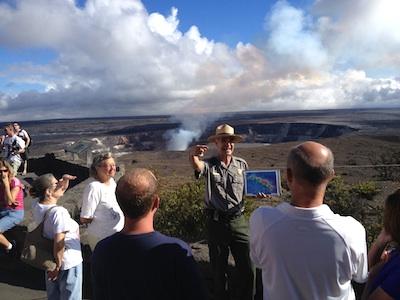Anniversary celebrations can lose their newsworthiness over time, but when the anniversary marks the fifth year of continuous eruption of the Kīlauea Volcano’s at Hawaii Volcanoes National Park, well, it's something to note.
Come March 19, that anniversary of the eruption within the volcano's Halema‘uma‘u Crater will arrive, and to mark it rangers will offer additional “Life on the Edge” talks at the Jaggar Museum observation deck, which overlooks the fuming, enlarging summit vent. The 20-minute talks, offered on Mar. 19 at 10 a.m., 11 a.m., noon, 2 p.m., 3:30 p.m. and 5 p.m., encompass the dramatic geological and mythological history of Halema‘uma‘u Crater.
Kīlauea’s summit vent opened at 2:58 a.m., HST, on March 19, 2008, when an explosive eruption created a gaping hole about 115 feet wide on the south wall of Halema‘uma‘u Crater. Nighttime glow from this hole suggested the presence of molten lava, but it wasn’t until six months later that a lake of roiling lava deep within the vent was definitively observed by U.S. Geological Survey Hawaiian Volcano Observatory (HVO) scientists.
With the opening of the Halema‘uma‘u vent, already high summit sulfur dioxide (SO2) gas emission rates increased even more, resulting in increased vog (volcanic air pollution) downwind. Although the summit SO2 emissions have declined since 2008, they are still averaging 800-1200 tonnes/day, creating hazardous conditions along closed sections of the park’s Crater Rim Drive and poor air quality farther downwind of the vent.
Since 2008, rock collapses within the vent have enlarged its opening on the floor of Halema‘uma‘u Crater. The vent is now about 520 feet by 700 feet (the area of about 21 Olympic-sized pools), and, according to HVO Scientist-in-Charge Jim Kauahikaua, is likely to continue growing through further collapses of overhung sections of the vent rim.
Mr. Kauahikaua describes the lava within the vent as a continuously circulating gas-rich “foam” that rises and falls depending on changes in Kīlauea’s subsurface magma pressure. The lava lake reached its highest level to date on Oct. 26, 2012, when the lava surface rose to within 72 feet of the vent rim.
While the actual lava lake is not visible from safe viewing areas, its glow—the diffusion of incandescent lava light within the gas plume rising from the vent—is spectacular and easily observed from Hawai‘i Volcanoes National Park overlooks on clear nights. When the lava lake level is especially high, park visitors can sometimes hear sharp sounds as rocks in the vent wall expand and crack due to the increased heat.
“The amazing beauty of this eruption, and the ease of viewing opportunities within Hawai‘i Volcanoes National Park, provides both visitors and residents with unforgettable experiences,” said park Superintendent Cindy Orlando. “Where else in the world can you park your car, and walk just a few feet to behold the spectacle of one of the world’s most active volcanoes?”
Jaggar Museum and the overlook are wheelchair- and stroller-accessible. Other vantage points for viewing Halema‘uma‘u within the park include Kīlauea Overlook, Kīlauea Iki Overlook, and Keanakako‘i Overlook.
The summit eruption can also be experienced through photos, videos, and webcam images posted on HVO’s website.




Add comment